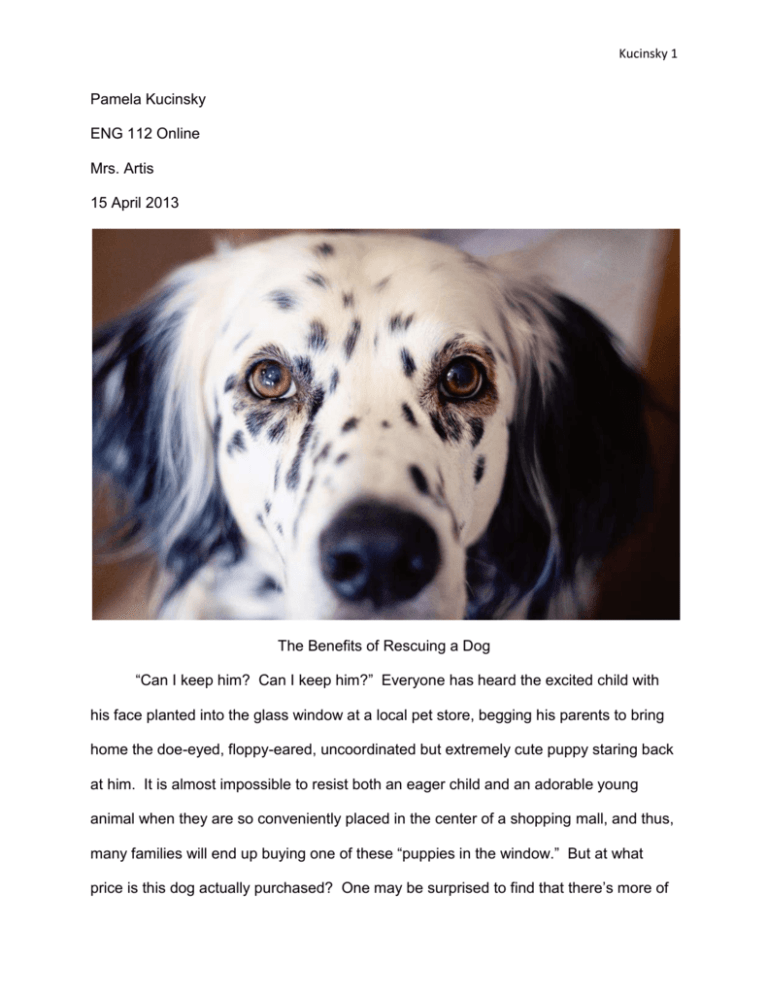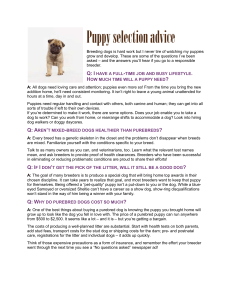File
advertisement

Kucinsky 1 Pamela Kucinsky ENG 112 Online Mrs. Artis 15 April 2013 The Benefits of Rescuing a Dog “Can I keep him? Can I keep him?” Everyone has heard the excited child with his face planted into the glass window at a local pet store, begging his parents to bring home the doe-eyed, floppy-eared, uncoordinated but extremely cute puppy staring back at him. It is almost impossible to resist both an eager child and an adorable young animal when they are so conveniently placed in the center of a shopping mall, and thus, many families will end up buying one of these “puppies in the window.” But at what price is this dog actually purchased? One may be surprised to find that there’s more of Kucinsky 2 a cost than just the bottom line at the cash register at a pet store. Almost all pet stores, especially the commercialized ones found in places like the malls, utilize poor quality distributors, and even puppy mills, when buying their dogs. A little bit of behind the scenes knowledge can enlighten those in the dog market to choose a better alternative. Choosing to adopt a rescued dog, or at the very least doing considerable research to find a responsible breeder, will put a strain on the puppy industry and force sellers to use better sources that ultimately end awful practices of puppy mills and profit breeding. If pet stores are out of the equation, what exactly is the alternative? What does rescue mean? To evaluate the other option to bringing home a family pet, one must know and understand the various types of rescue platforms and the mission of each. Rescues can be broken down into government facilities like a county shelter, national organizations like ASPCA and SICSA, and local non-profit volunteer groups. While they all take different angles, the bottom line is the same: finding permanent homes for misplaced animals. The biggest distinction from these forms of adoption groups and the more mainstream options like breeders or stores is that the dogs have been brought in from some sort of unstable situation and are being “re-homed” while the latter “produce” dogs for sport, show, or profit. Because most rescues are not-for-profit or governmentfunded, they typically only have enough overhead to cover the operational expenses to keep the organization running. This means they rely almost entirely on volunteers, specifically fosters to keep the animals when shelter space is limited. Not only do fosters save room in already overcrowded facilities, they also help rehabilitate animals that are often abused and untrained (Swanson, “Half Way Home”). Kucinsky 3 It goes without being said that rescuing is not an original source of the dogs themselves; they all come from a breeder of some sort. And with breeding comes a lot of variables that distinguish responsible breeders from those less so, to include the infamous puppy mills. Breeders can be found locally, nationally, and online. Though one is not necessarily better than the other, there are perks to each and red flags that any potential adopter should know. Smaller, local breeders tend to only have one litter at a time and often breed their family pets. This means that they are very knowledgeable in the bloodline and health history of their litters, but there aren’t any governing regulations to oversee these sales and inbreeding is not uncommon. Larger and nationally recognized breeders like the American Kennel Club parent club breeders are bound by both the breed’s standards as well as the organization’s regulations. They are also overseen by the United States Department of Agriculture. The downside is that these dogs tend to be pricey because the adopter is paying for the pedigree, not the pet itself. Lastly, the most unregulated option is online. Internet breeders do not have to follow any of these regulations or the USDA’s guidelines; they can have many litters of varying breeds at once, and often sell illegally acquired animals. As covered in the article by L.K. Lord and associates, “Breeders who advertise at one of the large-scale puppy sales websites are less knowledgeable about breed-specific health issues compared to an AKC Parent Club breeder. Internet breeders are less likely to perform these screening tests on their breeding dogs and may breed dogs with undesirable heritable health risks.” The forefront of irresponsible breeding, and one of the hottest topics animal rights’ organizations, is the issue of puppy mills. These mills are most literally “dog Kucinsky 4 factories” that mass produce purebred puppies strictly as distributors to sell to commercial pet stores. The dogs are kept in kennels and only exist to be bred; they receive little to no health care, live in extremely unsanitary conditions, and have no regard to the amount or effects of inbreeding or over-breeding. By the time these puppies reach the pet store, they can have irreparable damage. Not only do they carry genetic disorders, they are malnourished and not at all socialized. In a Q & A article for the Toronto Star, writer Yvette Van Veen urges readers to be patient with their puppy mill puppies because of all the issues they bare; she states something as simple as playing with a ball can be frightening and unfamiliar to them, and will take more time to get them accustomed to the activity than other dogs. This past Christmas, the ASPCA published a public service article to help inform readers what exactly they’re supporting when they buy a pet store dog, or even merchandise from these stores; the profits end up supporting puppy mills in the end (PR, Newswire). With the dark side of breeding exposed, and the idea of rescuing introduced, is rescuing as an alternative really the best choice? The obvious pros are that animal rescues save countless lives and hack away at the profit margin of crooked breeding. But from testimonies of those working in rescue, there is an emotional reward involved as well. Susan England, founder of Ohio English Setter Rescue, puts her experiences of both rescuing her own dogs as well as running OESR into words through a personal interview. “Rescuing a dog had a huge life changing impact on me. I started a rescue due to adopting from a rescue when I saw the overwhelming need. …. My dogs also helped me overcome a lot of my fears and anxieties. I had to go out on a limb constantly and take risks with them…. It has been incredibly fulfilling. My dogs make Kucinsky 5 my heart full, and I am happy knowing I am offering them a great life, and they offer me one too.” As Susan states, she had to take risks when the rescue was involved. And anyone involved in rescuing will attest that it’s not easy. There are more homeless dogs than adopters, much of whom require extensive health and behavioral rehabilitation. Though fosters act as a buffer to help overcome these issues, adopters of rescue dogs have to be prepared for these circumstances. While good breeders will know the health history of their dogs and litters, rescues tend to have very limited historical data. They usually only receive a snapshot of the dog’s former life, and must deal with situations as they arise. Though there are multitudes of reasons that dogs end up without a home, abuse and complex health problems are top of the list. When comparing two of her rescued dogs of the same breed to her others, an interviewee notes the rescued animals are shy and timid, and one has aggressive tendencies if threatened (Canan). Likewise, Susan mentions her adopted male as a “door bolter, inside marker, and leash reactive.” She also notes that her first dog from a breeder is much more trusting. Although these are not the rule, they are examples of how rescuing may be a tall order for some families. But not all homeless dogs come with this type of baggage. Some simply escaped their yards and never made it home before they were picked up by authorities, and some are owner surrenders due to the economy or the owner’s own health. And sometimes, it is simply a lack of knowledge or experience on the former owner’s part that leads their dog into a shelter; it takes patience and understanding when dogs have behavioral issues, but the right training can overcome these more often than not. Again, this is where the idea of fostering comes into play. Some Kucinsky 6 rescues even partnered with prisons, pairing inmates with dogs to train them before they are put up for adoption. This is therapeutic for both parties and cost effective. To summarize, rescued dogs may be challenging, but they do have great benefits. Every dog that is adopted from a non-profit organization reduces the demand for puppy mills and other crooked breeders. To anyone considering bringing a dog into the family, there are several things to consider. First, is the purpose to simply have a pet, or to have a dog for sport or show? If the latter is the case, the family would be wise to look for a creditable and caring breeder. They should avoid internet sites that have offer multiple breeds for sale, have apparently high prices, or are willing to negotiate price, and cannot answer breed specific questions. Also, third party sites like Craigslist are highly trafficked with people selling poor quality dogs, or even stolen pets. These, too, should be avoided. (Swanson “Adopt a Dog the Right Way). If a family pet is the desire, potential adopters should not be drawn by window displays and cute advertisements of pet stores. Instead, they should consider what breed and age of dog would best suit their lifestyle and do their homework on any they consider. When they are ready to adopt, shelters and local rescues are great places to start. Shelters often have puppies and occasionally rescues do as well, but they both house many adult dogs in need. They must be willing to accept any difficulties that may come with these dogs and understand that a lot of the problems are manageable and usually reparable with time. But they will have a dog forever grateful to have a home and also have their own gratification that they have saved a life. Kucinsky 7 Works Cited Swanson, Debbie. “Adopt a Dog the Right Way.” Dog World. January 2012, vol. 97, issue 1, p. 40-43. Swanson, Debbie. “Half Way Home.” Dog World. January 2011, vol. 96, issue 1, p. 36-39. PR, Newswire. “ASPCA ‘No Pet Store Puppies’ Campaign Urges Consumers Not to Buy Into Puppy Mill Cruelty This Holiday Season.” PR Newswire US 4 December 2012: Regional Business News. Web. 11 March 2013. Van Veen, Yvette. “Be Patient with Fearful Pet from Puppy Mill.” Toronto Star (Canada) n.d.: Newspaper Source. Web. 14 March 2013. Lord, L.K. et al. “Characterization of Advertisements for Puppies Sold Online: Determinants of Cost and a Comparison with Parent Club Breeders.” Preventative Veterinary Medicine 100. (n.d.): 200-209. ScienceDirect. Web. 14 March 2013. England, Susan. Personal Interview. 12 March 2013. Canan, Jessica. Personal Interview. 13 March 2013. England, Susan. Guinness. 2012. Photograph. Susan England Photography.



